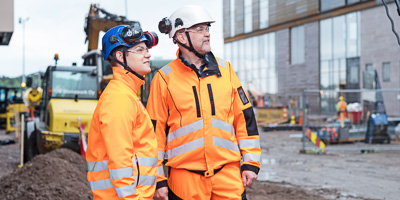Musculoskeletal (MSK) health
You can promote musculoskeletal (MSK) health and prevent musculoskeletal symptoms and disorders (MSD) by developing competence, ways of working, workspaces, equipment, and tools at your workplace. At Ilmarinen we provide you information on means to promote musculoskeletal health, work ability and functional capacity at your workplace.
What does musculoskeletal health and functional capacity mean?
Functional capacity means a broad and holistic view of a person’s ability to perform the activities of daily living that are important to them in the environment where they live and function. (WHO 2001.)
Physical work ability and functional capacity mean an employee’s characteristics and capabilities to cope with the daily physical demands at work and during free time.
Functional capacity can be divided into general endurance, muscular strength, and motor skills. The different activities of daily life and work tasks require varying degrees of functional capacity in these three areas. An employee’s functional capacity may be sufficient even if they suffer from a musculoskeletal disorder (MSD) or injury. Or the situation may be the opposite. Even if an employee does not have an MSD or injury, their physical work ability and functional capacity can be clearly impaired and insufficient for work that requires physical effort.
Good functional capacity requires regular maintenance and physical activity to support musculoskeletal system take the strain of decades of daily use. Promoting MSK health through exercise also has an impact on our most common national diseases. There is clear evidence from studies that exercise is essential for reducing the risk and treating more than 20 diseases. Exercise also supports mental health and is one of the non-medicinal treatments for mental disorders, supporting other forms of treatment.
On the other hand, it is also good to remember that a healthy lifestyle and regular exercise do not protect against MSK symptoms if the person’s work is physically straining and involves risk factors.
Musculoskeletal conditions – temporary symptoms or disorders?
Almost all of us experience some musculoskeletal symptoms at some point in our lives. Common musculoskeletal symptoms include degenerative conditions (e.g., arthrosis), inflammatory conditions (e.g., rheumatoid arthritis) and disorders followed by excessive strain or injuries. Degenerative symptoms typically develop gradually over time and manifest at a later age. Although MSK symptoms appear to start suddenly, they develop over lengthy period at work and during free time as a result of strain caused by sustained awkward postures and repetitive movements, use of strength, soft tissue damage due to injuries and a combination of several workload factors, and, very often, also insufficient physical exercise. A strenuous task (e.g., a heavy lift) or an accident can also cause impairment.
MSK symptoms affect work ability in different ways. Typically, they are minor symptoms that pass within a few hours or lead to a short sick leave. In some cases, the symptoms may be severe or they can become chronic, leading to prolonged or even permanent disability. Musculoskeletal pain impairs workflow and reduces the productivity of work. It also increases the risk of injuries.
Read on to find out about physical symptoms and what to do about them.
-
The most typical symptoms are pain and various limitations of movement. The employee may, for example, have difficulty lifting or twisting their upper limb, bending their back forward or squatting. Even if there is no serious condition, the pain and limitations of movement can be very severe at the beginning. Pain is often interpreted as a sign that the sore body part should not be moved at all. Intense pain also often causes fears and concerns. Once the doctor has excluded a serious condition, immobility usually does not relieve the MSK symptoms; on the contrary, it even aggravates them in the longer term. Therefore, immobility is usually a bad choice.
-
MSD recovery can be promoted both at work and during leisure. The usual recommendation is that a person with symptoms should reduce harmful strain while trying to move and function as normally as possible.
- At the workplace, this can be supported by accommodating work so that harmful strain is reduced or eliminated completely for the convalescent. Ask the occupational health services for support. The occupational health physiotherapist applies ergonomics solutions in work accommodation and assists both the supervisor and the employee.
- If the employee has difficulty moving normally due to pain and motion limitations, they can turn to the occupational health physiotherapist. The occupational health physiotherapist can give advice on how to move safely and as painlessly as possible and also on non-medicinal treatment of pain.
- Moving in pain requires motivation. When moving is painful, motivation is key. Psychosocial factors also affect motivation. Negative factors include tiredness caused by the stress and strain both at work and in private life or sleep disorders. Positive factors include the support provided by the work community, family, and friends.
The earlier the person gets help for their symptoms and support for their recovery, the less likely the situation creates a vicious circle, which can lead to permanent impairment and chronic pain.
-
Many musculoskeletal disorders are characterised by symptoms that vary between persons and over time. The impact of the pain and limited ranges of movement on work ability and functional capacity thus varies greatly. The same type of tissue damage, such as spinal disk herniation, causes different symptoms or no symptoms at all in different individuals. In addition, two different disorders can limit work ability and functional capacity in the same way. For example, a post-fracture condition and rheumatoid arthritis can limit the movement of the wrist or hand similarly.
Therefore, at the workplace musculoskeletal disorders should be approached from the perspective of work ability and functional capacity.
Consider
- what the employee is still able to do.
- whether the situation is temporary or permanent.
When the person still has some functional capacity left and they can use it, it often contributes also to their mental and social well-being.
Five common misconceptions
Source: Kendall, Burton, Main & Watson, 2009. Tackling musculoskeletal problems.
-
“All musculoskeletal disorders are caused by work”
This is true only in very rare cases. In fact, musculoskeletal disorders are common both at work and during leisure. They are seldom caused only by work unless they are the result of an occupational injury. In some jobs, the symptoms can hinder work or get worse.
-
“Musculoskeletal symptoms are always caused by an injury or disorder”
This is true only in rare cases. In most cases, the cause is a minor injury or no injury or disorder. Radiological and laboratory examinations usually do not reveal anything that could explain the symptoms.
-
“Work is always bad for a person with musculoskeletal problems”
In most cases this is not true. Work may seem difficult due to symptoms, but a suitable job supports recovery and does not cause any tissue damage.
-
“Rest and sick leave are needed to cure musculoskeletal conditions”
This is not true. In most cases, the best and recommended treatment is to resume normal daily activities as soon as possible. Most people continue to work despite their problems or return to work after a few days of sick leave, even if the symptoms persist. A long sick leave is very rarely beneficial, especially if work can be accommodated.
-
“A person with musculoskeletal problems must not go back to work until they are fully fit and pain free”
This is unrealistic and unhelpful. Continuing in suitable work and returning to work as soon as possible are important for rehabilitation and recovery. Everyone has the right to work and receive support as early as possible – keeping in mind the symptoms. It is possible to return to work from sick leave also before the sick leave ends, if this is agreed on with the employer and, if required, with the occupational health services.
Promote musculoskeletal health at the workplace
Physical strain is necessary for a person’s well-being. That is why there is no need to eliminate physical strain at work. Work that requires various forms of physical effort maintains and promotes health. Therefore, the objective is to find a suitable workload, which varies somewhat between individuals according to body structure, gender, and age.
Ergonomics – a key tool at the workplace
Ergonomics has been used to develop work, tools and working conditions for more than a hundred years. Its importance shows in the equipment, furniture and tools used at each and every workplace. Nevertheless, a lot remains to be done.
Workplaces can use ergonomics solutions to improve the smooth flow and quality of work. At the same time, ergonomics is a key tool for the workplace in promoting MSK health. It can also help prevent symptoms, disorders, and injuries, all of which entail extra costs for the company.
Physical workload factors that can be managed through ergonomics include, for example:
- frequent manual handling of loads
- prolonged static muscle work
- repetitive work, sustained postures, or the use of strength
- whole-body and hand-arm vibration
- these are coupled with psychosocial workload factors, such as high work demands and few opportunities to influence.
Improving work with the help of ergonomics is part of continuous development at the workplace. The employer creates the required framework and resources. The starting point for development is collaboration between supervisors, employees, occupational safety, and occupational health services. It is based on the continuous assessment of the workload factors and risks present in the work. Unergonomic and strenuous work phases are systematically documented, and goal-oriented efforts are made to reduce them. However, if an employee feels strain or develops symptoms, work accommodation measures should be carried out as early as possible. The occupational health partner and especially the occupational health physiotherapist support you in adapting the ergonomics solutions to match your company’s needs.
-

Employer and MSK health
As an employer, it is your statutory obligation to look after your employees’ safety and health at work, including MSK health.
Read about MSK health for employer -

Supervisor and MSK health
Supervisors can use many means to promote employees’ MSK health.
Read more about MSK health for supervisor -

Entrepreneur and MSK health
MSK functional capacity is an important part of your work ability, so take care of your resources and identify the workload factors.
Read more about MSK health for entrepreneur -

Employee and MSK health
MSK functional capacity is an important part of an employee’s work ability, so take care of your resources and address workload factors.
Read more about MSK health for employee